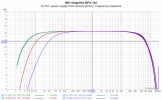- Joined
- Feb 23, 2016
- Messages
- 20,771
- Likes
- 37,635
So do I understand that last measurement correctly. That 10 mV will clip the input unless gain is less than 0 db?In french, we say "Un dessin vaut mieux qu'un long discours"
So here we go
I measured my Millennia HV-3C first
This is an analog preamp.
I measured it through the ADC of my RME ADI-2/4 Pro SE.
First for Max gain (60.6dB), with the RME on minimum ADC range (+1dBu)
(Changing the ADC range doesn't change the result here: Preamp's noise is well above the RME noise. What matters is only the Preamp gain.)
View attachment 324244
Then for a gain that gives me just below 0dBFS with a 10mVrms 1kHz signal
I kept the same ADC range first
View attachment 324246
Then I switched to 19dBu range.
To get 0dBFS on the ADC with the same signal, we need to increase the gain by 18dB.
(if I selected the maximum range, which is 24dBu, I couldn't get enough gain to reach 0dBFS with 10mV)
View attachment 324249
As one can see, we get pretty different results.
And we see that for best EIN results, it's better to have more gain and a higher analog output level on the preamp.
(By the way, it's the same if you want to cascade 2 preamps: You'd better maximize the gain on the first stage to get best results)
OK, here it is an analog preamp, and I can play with the ADC range, which allows this flexibility.
Now what happens with digital interface, where the ADC range is fixed ?
Let's measure with the RME 12Mic-D
We don't know the gain, but we may measure the value for 0dBFS in dBu
(Actually, RME is quite clear with the gain: 0dB gain = 18dBu for 0dBFS. Here, the gain is set to 56dB marking, since we target a level of -38dBu for 0dBFS)
View attachment 324250
We can then compare this figure with the previous one:
-127.97dBu un-weigthed vs -127.02 dBu for those 2 high end interfaces/preamps.
(Note that if we had selected a higher level for 0dBFS, like 20mV, as an example, the Millennia would have been able to take benefits of its higher output level - up to 28dBu before saturation - to close the gap with the RME)
Now, at max gain, the RME 12Mic-D gives us this
View attachment 324251
Not dramatically different.
For both examples, the EIN difference between max gain and 10mV range gain is around 0.1dBu.
So, so far, that gives some sense to the idea of measuring all interfaces at max "gain" for noise, if you don't want to go through the pain of explaining this "gain" topic to the readers.
Even if I still think that aligning sensitivities or "gain" is a more scientific way of doing it.
Similarly, measuring dynamic range at lowest "gain" (on mic input, without any pad inserted) probably makes sense.
But we'd still need our "Dashboard" and a set of all usual measurements, to be done at a standardized level AND sensitivity or "gain".
So, say, 4V at -6dBFS (or -3dBFS, if 8V is too big of a range for cheaper interfaces) as an example.
Next, I tried something seriously less good.
Here is the BlackmagicDesign ATEM Extreme ISO video switcher's Microphone input.
"Gain" is set to -1.5dB, for 10mV at -0.2dBFS
View attachment 324484
Interesting to see that the CCIR-2k value here is almost identical to the un-weighted value.
The good thing is that we may now really compare this one with the other ones.
Not really a contest, as expected, of course...
We are virtually at max gain here, so I didn't measure it any further.
That is what I thought would be so useful about using 10 mV. We can see what sensitivity is or looking at it backwards what level is max input for the device along with using the same setup to do a useful EIN comparison. Some devices have low max input levels and average gain, others have higher max input levels and average gain. One thing you want to know is will the gain to 0 dbFS work for any given microphone you are wishing to use. I forget, but one interface I saw was optimized for dynamics and ribbons. It had only 50 db of gain, but the ADC sensitivity was such that max input was only 0 dbU for 0 dbFS with 0 db gain. You wouldn't even be able to use a large condenser with it unless you had a PAD added to it.

